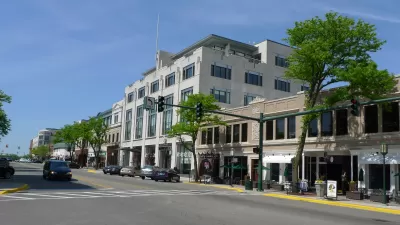“Lean urbanism” is the latest buzz-worthy term to enter the discussion on planning and urbanism. A recent article in Atlantic Cities explains the concept—which appeals to the younger generation as well as those with libertarian leanings.

Anthony Flint recently interviewed Andrés Duany on the subject of “lean urbanism,” which recently received a high level of institutional backing in the form of a $600,000 grant from the Knight Foundation for work in Detroit. For those interested in learning more about lean urbanism, Flint’s interview provides access to this latest concept in the lexicon of planning.
According to Duany, red tape is the problem: “Common sense has been almost completely lost in my profession. There are too many protocols in the way.”
“The lean urbanism concept, he says, is like a software patch, or a workaround – ultimately a guide or a tip sheet to navigate the complicated, and often very expensive, maze of working in the built environment in the U.S.,” writes Flint. Duany describes lean urbanism as “not a philosophical approach, but a narrow seam of activity, a sharing of secret knowledge.”
For how lean urbanism relates to the constellation of concepts by which planners and urbanists organize their ideas, Flint compares the work of lean urbanism to more familiar projects. “Tactical urbanism – the unsanctioned demonstration projects of creating a parklet or ‘chair bombing’ a street – might be thought of as at one end of this spectrum. Groups like CNU, the American Planning Association, the Urban Land Institute and SmartGrowth America are operating at a higher political level, pushing policy reform. Lean urbanism, as Duany defines it, seeks to occupy the space between, helping guide urban development in a more practical manner.”
FULL STORY: Why Andrés Duany Is So Focused on Making 'Lean Urbanism' a Thing

Planetizen Federal Action Tracker
A weekly monitor of how Trump’s orders and actions are impacting planners and planning in America.

Map: Where Senate Republicans Want to Sell Your Public Lands
For public land advocates, the Senate Republicans’ proposal to sell millions of acres of public land in the West is “the biggest fight of their careers.”

Restaurant Patios Were a Pandemic Win — Why Were They so Hard to Keep?
Social distancing requirements and changes in travel patterns prompted cities to pilot new uses for street and sidewalk space. Then it got complicated.

Platform Pilsner: Vancouver Transit Agency Releases... a Beer?
TransLink will receive a portion of every sale of the four-pack.

Toronto Weighs Cheaper Transit, Parking Hikes for Major Events
Special event rates would take effect during large festivals, sports games and concerts to ‘discourage driving, manage congestion and free up space for transit.”

Berlin to Consider Car-Free Zone Larger Than Manhattan
The area bound by the 22-mile Ringbahn would still allow 12 uses of a private automobile per year per person, and several other exemptions.
Urban Design for Planners 1: Software Tools
This six-course series explores essential urban design concepts using open source software and equips planners with the tools they need to participate fully in the urban design process.
Planning for Universal Design
Learn the tools for implementing Universal Design in planning regulations.
Heyer Gruel & Associates PA
JM Goldson LLC
Custer County Colorado
City of Camden Redevelopment Agency
City of Astoria
Transportation Research & Education Center (TREC) at Portland State University
Camden Redevelopment Agency
City of Claremont
Municipality of Princeton (NJ)




























